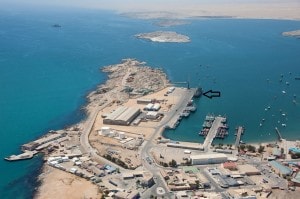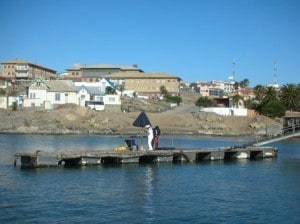Today was a sea day and we have been sailing with the sedate speed of 14 knots along the coast of South Africa and Namibia. The coast with its brown mountains was just visible in the hazy distance. We are having a very strong breeze of 26 knots blowing with us; which gives a relative wind of 12 knots and that makes it very pleasant on deck as the wind cools down the temperatures which reached the mid 70’s today. We are sailing with a slow speed as the distance between Capetown and Luderitz is one of those stretches, if you go full speed, you will arrive in the middle of the night. I have been given to understand that the night life in Luderitz is less than dynamic and thus the ship aims to be at the anchorage around 0700 maybe somewhat earlier. We cannot dock here as the bay is too shallow and hence we have a long tender distance to reach inside the port.
As messing around with boats always has an inherent danger to go wrong, a tender port is even more meticulously planned than a docking port. Thus the Navigator in charge prepares a presentation for everybody involved and a Tender Briefing is held the day before. Thus today. As that is of interest to us as well we had the whole group of trainees attend. We learned that Luderitz is located inside a bay and that it is thus well sheltered from anything that is not blowing directly from the North. Such an event is not forecast and that means nice sunny weather tomorrow with only a gentle breeze blowing. (Approx. 8 knots)

The tenders have to sail from the far left of the photo, around the North Point, all the way down to the small jety in the bottom of the photo . (Photo courtesy Stock Photo from the Internet)
Less welcome was the realization that it is a long tender ride from the ships anchorage, around the corner into the bay, to the floating tender dock. There is a shoal that moves around and the far North end of this shoal is marked with a buoy. Still the local authorities do not seem to be convinced that the buoy stays with the shoal or vice versa and tomorrow each Tender will have a local pilot on board to ensure that the tender gets to go where it has to go.
This route is carefully discussed with the tender drivers to ensure that all understand on what side of the buoy they will have to stay. Having the benefit of a local pilot’s wisdom can only help the situation. A cruise ship that comes into port creates a sort of local invasion but when the ship is docked that is normally not noticed that much. When at anchor it becomes more evident and therefore apart from the Nautical people also Housekeeping was in attendance. When the first tender goes ashore, there are normally no guests onboard the tender as the ship has not been cleared yet. Even if they were allowed, there would be no room as all the gear that has to go ashore takes up most of the space inside the tender.
Hotel has a whole protocol to adhere to when being in a tender port and the Exe. Housekeeper is always very eager to have that protocol followed. A whole army of Housekeeping attendants then descends onto the tender, and later ashore, carrying umbrella’s, tables, towels, folding chairs, security stands, gel dispensers (against NLV) and if the wind is not too strong, also a tent for providing shade. Then about 2 hours after the tender service starts, BLD (Beverage people) or the dining room arrives ashore with coolers of Ice Tea and orange juice. By that time we also start offering cold towels for those who braved the warm shore side.

Photo from a previous call. The dock is not exactly made to sustain the weight of a large number of people. Small groups have to come down from the main dock.
The final challenge will be traffic control. The tender dock ashore is a floating dock. As is generally known; something that floats can sink when overloaded. Looking at the photos I do not think that the tender platform can handle too many guests standing on it at the same time and thus we will need some sort of Traffic Control to stagger the people when going back to the tender.
We will see how that goes. Also arrival might be interesting as the local authorities have decided that all guests will have to be seen by immigration for a face – to – face passport comparison. We just had one in Cape Town and now we have to do it again.

Leave a Reply